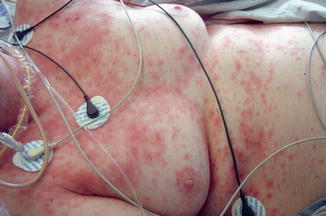Allergic
Toxic
Clinical
Urticaria, morbilliform, etc.
Mimics action of drug
Histopath
Nonspecific
Mimics action of drug
Dose of drug
Not dose-related, idiosyncratic
Less dose may cure;
Universal at high enough dose
Complications
Can develop anaphylaxis
Excessive bleeding
Treatment
Antihistamines, corticosteroids
Stop the medication
Cross reaction with other meds
Common
Does not occur
Treatment
My treatment for urticarial drug reactions is a nonsedating antihistamine, adding histamines at several-day intervals, working up to sedating antihistamines and a 10-day course of oral Prednisone, or intarmuscular Celestone (6 mgms/cc) or 1 cc, Kenalog (40 mgm/cc.) The Celestone lasts 1–2 weeks. The Kenalog lasts 3–4 weeks. The Prednisone dose that I use is (10 mgm/tab) 5 tabs each am with food, and lower by 1 tab every 2 days for a total dose of 30 tabs over 10 days. I have this prescription pretyped since I use it so often. (For nonurticarial drug eruptions, I use the antihistamines only to treat symptoms and the steroid regiments above to treat the rash.)
If the urticarial eruption is associated with shortness of breath, wheezing, trouble swallowing, lightheadedness, and diaphoresis, I use subcutaneous epinephrine with a dose based on weight, and admission to the hospital with intravenous corticosteroids and antihistamines, and, most importantly, elimination of all drugs. Remember that mouthwash, breath fresheners, birth control pills, toothpaste, candies, inhalants, eyedrops, medication patches, and topicals (especially on mucous membranes) can all be culprits for minor or major drug reactions and need to be considered as the cause.
Making the Diagnosis
In general, a drug eruption should be suspected if the skin condition is symmetric, generalized, and sudden in onset (Fig. 2.1). Once suspected, there are three basic ways to discover the underlying cause in patients on multiple drugs:


Fig. 2.1
A morbilliform drug eruption (which is the most common) over the anterior trunk due to Tegretol use. Notice the monotony of individual papules that maintain the same color and coalesce into a symmetrical distribution. Sparing in the intertriginous areas, as it does here, or at sites of pressure, is common
1.




Discontinue the suspected drug and see if the skin condition resolves. Remember that untreated drug eruptions can last 2–3 weeks. Rechallenge, if the reaction was not severe and if the drug is felt to be essential, it can be tried again.
Stay updated, free articles. Join our Telegram channel

Full access? Get Clinical Tree


